|
|
Medford in 1923 Also see the Bixby columns for this year.
MEDFORD. Jackson
County. Population 5,756. Is the commercial and business center of
famous
Rogue River Valley, Southern Oregon. It is located on the Southern
Pacific railway and on the Pacific Highway. It is a terminal for the
Medford Coast Railroad, which line is electrified. The elevation of
Medford is 1,368 feet. The average
temperature for the past 20 years has been 55 degrees. The annual
rainfall
is from 18 to 22 inches. Surrounded by 25,000 acres of irrigated lands.
Medford is the gateway to Crater Lake. Auto stage every day. It
has a cosmopolitan population; people from every state in the Union
have come here to make their permanent homes. The following are some
facts about Medford: The best paved city for its size in the world,
having 25 miles of
pavement; 26.21 miles of sewers; water mains 28.45 miles, cement
sidewalks, 4 grade schools and one high
school, St. Mary's Academy, business college, conservatory of music,
and a kindergarten.
Modern-equipped fire department, electricity and gas for lighting,
heating and
power purposes, 4 banks, a public library, 3 modern hotels, 3
second-class hotels, 5 restaurants, 6 apartment houses, 3 weekly and 1
daily newspaper,
city park, baseball park, fair grounds, auto camp grounds, country
club. Five ladies'
clubs, farm bureau cooperative exchange, Chamber of
Commerce. All denominations of churches, two hospitals, opera house,
two
movie houses and a natatorium. All leading lodges and societies.
Federal building and offices of weather bureau, district forestry, U.S.
[plant] pathologist. Public market, jobbing
and wholesale center, aviation landing field. Auto stages--interurban
auto routes to
all points of Southern Oregon, hourly service to Ashland. Auto stage to
Roseburg and Klamath Falls, stops at all towns along line; also auto
stage station on
line from Los Angeles to Portland. Has 4 lumber mills, one of which has
a daily capacity of 125,000 feet.
Two box factories, 2 large creameries, 2 fruit and vegetable canneries,
fruit evaporating plant, pickling and catsup works. Eight fruit
associations with 2 large pre-cooling plants. The district surrounding
Medford is the greatest pear country on the coast and one of the best
apple-growing districts. Stock raising and diversified farming are
among the greatest resources of the valley. Pacific Telephone
& Telegraph Co., Independent
Telephone
Co. Telegraph Western Union. Express American Railway.
page 299 Abbreviations spelled out to facilitate searching. HEARD AND SEEN ON CITY STREETS
To satisfy my curiosity I stopped for a few moments the other evening
to swap comments with a dilapidated specimen of humanity who was
toasting something over a fire he had built alongside the railroad
track. No, he was no philosopher in disguise; no E. V. Lucas
getting a background for his exquisite travel stories. He was just a
bum. A very ordinary and dirty bum. Except for one thing he was just
the typical product of ignorance and laziness, and that was that he had
a notion that in the befuddled avenues of his brain was the solution of
all our industrial troubles, for he was a Wobbly of the simon pure variety.(BY B. F. LINDAS) ---- A STRAY WOBBLY "I ain't going to be tramping this way all the time. Youse fellows who have been robbing the working man will get yours, all right. We built these railroads, didn't we? And all we get is a chance to walk the ties. Hell, ain't it? Someday we're going to take what we want. Then you guys with the white collars will have to get to work." That wasn't all he said. He was the incarnation of bitterness and hatred. If he wasn't already a criminal he had the making of one. And yet the chances are that since he left the ancestral roof he had done nothing for the good of the country or himself. Just an uneducated malcontent. With a world of opportunities all about him, he and his kind wander along spreading poisonous gospel. One of the chief problems of our civilization is going to be in keeping all this human driftwood from jamming against the foundations and destroying the whole structure. ----
One
day last week I had to spend several minutes waiting for a freight
train to pass our one business street, and while admiring the beautiful
box cars that seemed to stretch a mile in both directions, two young
ladies edged their way through the crowd and stopped directly in front
of me. They were young; very young; possibly 15 or 16. Their hair
was bobbed and curled. Their eyebrows were penciled, their cheeks
powdered and rouged, and their lips crimsoned into a Cupid's
bow. Tight-fitting sweater; skirt that barely reached the knees and
silk stockings completed the equipment. They were talking a blue streak
when I first noticed them. This is all I unwilling overheard.UP-TO-DATE YOUTH "Jack brought me a box of Murads last night. But I don't like them. I like Turkish better." "Oh, does your mother let you smoke?" "No indeed. But whenever I smoke I just burn some incense afterwards and Mother never notices it." Now I haven't any comment to offer. I don't know what to do to stop 16-year-old girls from smoking. I just happened to hear this on the streets of Medford. Ben Lindsey of Denver says the flapper is needed to assert the rights of youth over those of age. Perhaps he is right. I wonder. ----
Just after the train had passed and the flappers had flapped their way
down the main street, I stopped to greet a friend near the Chamber of
Commerce building. If in any place in the Swiss Alps there nestles a
village with a more beautiful outlook than Medford, it would be well
worth going to see. On this particular day the view was entrancing.
Toward the west the Coast Range was tipped with snow. The air was so
clear that one could almost distinguish the individual trees, their
dark green boughs powdered with the pale crystals. In the direction of
Gold Hill a shaft of sunlight through the scurrying clouds colored the
foliage with the burnished glow of the yellow metal that made it
famous. The jagged top of the Siskiyous were hidden in a dark cloud and
over the symmetrical slope of Roxy Ann was arched a beautiful rainbow.
I wonder how many cities, large or small, can disclose this sort of
panorama from a busy corner of its main thoroughfare.WESTERN SPRINGTIME ----
I was talking with a friend of mine near the library park one noon
hour. Suddenly I noticed a man coming through the park swinging an
umbrella. He had a derby hat on his head, rather the worse for wear,
and sported sideburns down the sides of his cheek. He had a peculiar,
hunted look and walked with a wide stride, the bottom of his trousers
scarcely reaching his shoe tops.THE DOPE PEDDLER "Who is that fellow," I asked. "That is the fellow who peddles dope around here," answered my friend. "Peddles dope? Here in Medford?" "Yes, and has been doing it for some time." In the meantime the fellow had hurried along, turned the corner towards the post office and disappeared. I hope my friend was mistaken and that this worst of all evils will be kept from the splendid little city of ours. If it should be true that someone has started a traffic in these deadly drugs they should be handled without gloves. ----
The
old fellow was just about five feet tall but ruddy and healthy looking.
He had a shock of gray hair, heavy gray eyebrows, and bright eyes that
blinked at you narrowly from his plump cheeks. His back was bent and he
leaned on a cane as he walked. When I first spoke to him, he looked at
me steadily for a moment or more before answering, then he told me a
number of interesting details of Southern Oregon. He came over the
plains in the early sixties; he was in Jacksonville in its palmy days;
he had a claim on a creek a mile or so from the town. He was in this
frontier settlement when to be quick on the draw was the best insurance
of good health and long life. He told me of some of the queer customs;
of how each particular trade used to have its day in town for getting
drunk, and that the only offense was becoming intoxicated the wrong
day. He told me how the saloons and stores were lighted with candles
imported from China and stuck around on the walls and hung from the
ceilings; He told me of how they managed the mail, by having a long
line formed one day a week, and then someone mounted a box and called
the names and the letter was passed down the line until it reached the
one to whom it belonged. He told me of the desertion of Jacksonville
and tales of all kinds about these early days. He could rattle off
stories of real life that rivaled the imaginative art of Bret Hart.
Then he told me that someday he was going to write a story of his life,
so that generations yet to be might know about the winning of the West.
It would be a fine thing to do. But, of course, he never will. He will,
like the Ancient Mariner,
tell his tale to everyone who will listen, but someday his voice will
be stilled and the stories and romance will be buried with him.THE OLD PIONEER Medford Clarion, April 27, 1923, page 2 Medford is the "biggest little city" in the West. In the heart of the Rogue River Valley, whose pears are known wherever fruit is eaten. Business center of Jackson County and of Rogue River district. Gateway to Crater Lake and other scenic wonders. Altitude 1350 feet. Population 7500. Southern Pacific Co., "Oregon for the Settler," August 8, 1923 edition, page 60 "THE GOOD OLD DAYS."
THE
GOOD OLD DAYS! Every now and then someone hereabouts heaves a sigh and
regrets that Medford isn't the Medford of the golden days--the boom
days--the get-rich-quick days of 1910-11.
To hear these gloomy goslings talk, one would suppose that Medford reached its pinnacle a decade ago and has been steadily declining ever since. As a matter of fact, the very reverse is true. Many years ago Medford did have a boom, which is only another term for an economic spree, and like most sprees in the pre-Volstead era, there was an awful headache the next morning. The good-old-day wailers have never gotten over that headache. Their heads have never cleared up. Nor their eyes. Convinced that the boom had busted, they proceeded to assume that Medford had busted, and they have been suffering under the delusion ever since. The good old days. Oh, if they would only come back. Well, let's hope they don't. For booms, while exhilarating, never last. And in the end they always cost more than they are worth. Today Medford is in better shape in every way than it has ever been before. It has more people, it has more homes, it has more money in the banks, it has more payrolls, it has more prosperity and it has better promise for the future than it ever had before. This isn't booster talk. It isn't even propaganda--as yet. It is the plain unvarnished truth supported by plain undeniable facts. The Medford Chamber of Commerce has recently completed what might be termed an economic survey of the city. The results have been charged. The survey includes everything from bank deposits to building permits, and from precipitation to postal receipts--and the index line of every chart is not only higher than in those so-called good old days, but in nearly every case has steadily risen ever since! These charts are soon to be printed in this paper [see below]. They will make excellent reading. The will be particularly excellent for those poor victims of the inferiority complex, who harp on the good old days, without realizing for a moment apparently that they can't hold a candle to the days that are here. Medford Mail Tribune, November 17, 1923, page 4 Medford
Has Found Itself 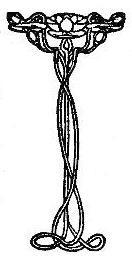 Chamber of Commerce Medford, Oregon What Does This Survey Show? That everything points to PROSPERITY and UPWARD DEVELOPMENT in Medford and vicinity. WHAT ARE THE REAL FACTS AS DISCLOSED BY VITAL STATISTICS? HOW CAN THESE TRUE FIGURES BE EASILY READ AND UNDERSTOOD BY BUSY PEOPLE? This booklet is the answer. Committee of the Medford Chamber of Commerce in charge of this survey. R. W.
RUHL, Chairman
W. H. CRAWFORD JOHN H. CARKIN Editorials
by R. W.
Ruhl.
 Once upon a time
Medford had a boom. Like most booms the Medford boom busted. Also like
most booms the Medford boom was followed by several years of acute
depression, rendered all the more painful by the contrast between
abnormal activity and subnormal activity. Once upon a time
Medford had a boom. Like most booms the Medford boom busted. Also like
most booms the Medford boom was followed by several years of acute
depression, rendered all the more painful by the contrast between
abnormal activity and subnormal activity.That Medford boom has never been forgotten. Its aftereffects have never been forgotten. But what has been forgotten, what very few local residents have apparently realized, is that several years ago Medford recovered from this boom collapse, regained its normal health, and since then has been going steadily forward, until today Medford is in every way in better condition than it has ever been before. In an effort to dispel this inferiority complex, to return Medford to that spirit of optimism and self-confidence and faith in its destiny, which the conditions justify, the Mail Tribune is starting today a series of statistical articles, illustrated by charts, showing in graphic form just what condition this city is in today, just what condition it was in during the so-called boom days, and just what condition it has been in during the period intervening. *
*
* *
These statistical
charts have been
prepared by the Medford Chamber of Commerce. But they are not of the
familiar and somewhat discredited "hot-air" type. It is not pretended
that they show Medford is once more a boom town, that the economic
millennium has again arrived, that all the people of Medford have to do
is open their eyes and see a city of 100,000 people tomorrow morning.Not at all. These charts are not even booster propaganda. In a sense, they are not propaganda at all. They are merely official facts, supported in every case by the official records, giving in chart diagram form the true history of Medford's business development during the past twelve or fourteen years, the good and the bad. Know Thyself! That is the idea. These articles are printed so that the people of Medford may know what their city really is, what its condition is today and therefore what it is reasonable to believe its future is to be. *
*
* *
The first charts
printed below show the
growth in building permits and telephones. In explanation of these
charts and those which follow it should be noted that no pretense is
made that this is a complete survey, or even that all important local
developments have been included. The committee in charge, instructed to
find out the precise business condition of Medford at the present time,
simply adopted the methods employed for a similar purpose in other
fields.Limited by space and time, the committee proceeded to investigate as many salient departments of the community as possible and particularly departments in no way related, so that the final result could be fairly termed representative. No attempt was made to pick and choose. What might be called "samples" were taken here and there without any particular system and the results tabulated. It might be stated at the outset that the committee members were amazed at the result. We believe anyone who carefully studies today's tables and those which will follow will also be amazed to find just how encouraging the local situation is. The first samples are printed below, and more will follow until the survey has been completed: 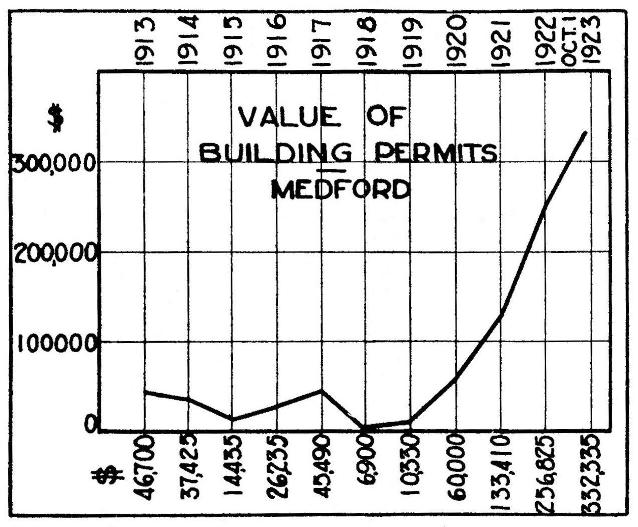 Building Permits. Medford
enjoyed no war prosperity, but since the war her growth and industrial
improvement has been steady and consistent. See how the building permit
curve has jumped upward since 1918 from a value of $6,900 to a value of
$332,335 for nine months of 1923, an increase of nearly 5000 percent in
less than one year. This record will undoubtedly be exceeded in 1924.
For Medford has a genuine house shortage. There is a crying need for
more homes to rent and buy, particularly of the better class. There is
a great opportunity here for business capital to make a safe and
profitable investment in new and modern home construction.
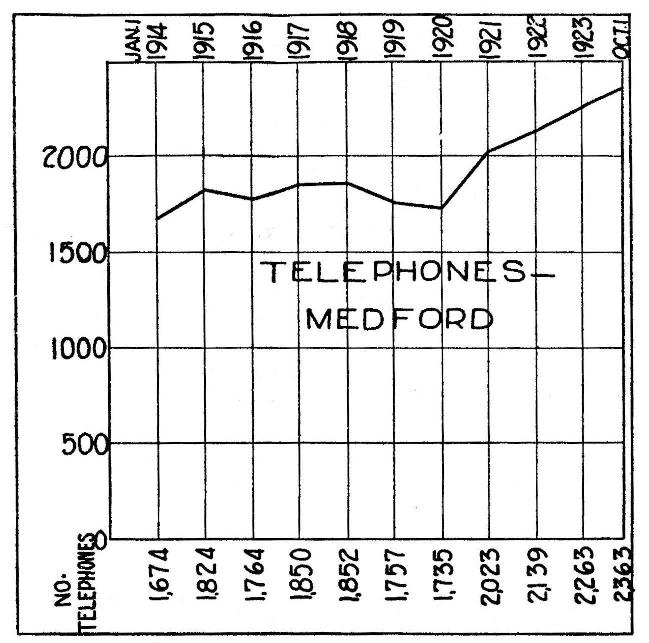 Telephones. This
chart tells the same general story. Over fifty percent increase in the
number of phones in Medford in the past nine years. The record starts
at 1674 phones in January, 1914, and the increase is gradual until
1920, when the number of phones jumps sharply upward.
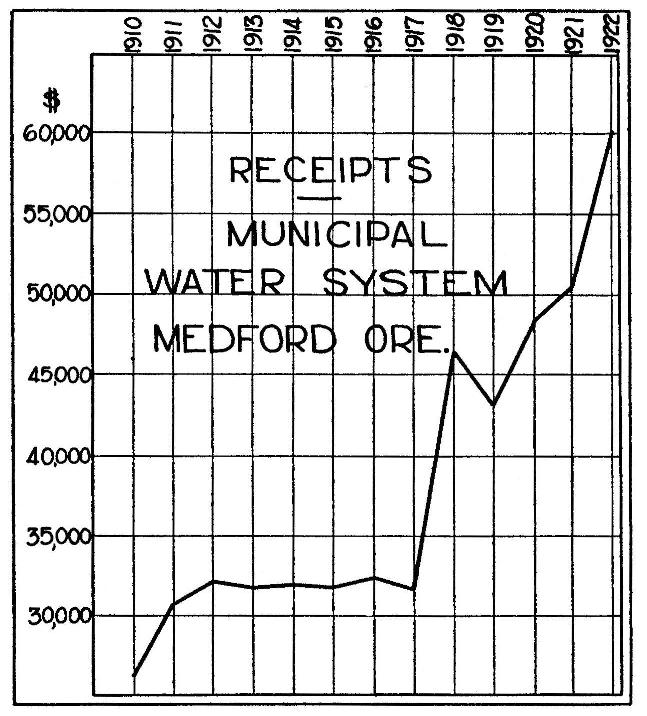 Receipts Municipal Water System.
In
these days everyone drinks water. The sensational increase in water
consumption indicated above merely confirms from another angle the
truth
of the statement that Medford is bigger and better today than ever
before in its history. Of course the almost perpendicular rise in 1917
is partly accounted for by the fact that water rates were increased,
thus increasing the receipts, but the fact remains that the receipts
since the boom year of 1911 have doubled, and are steadily climbing.
The main factor in this rise has been a steady and consistent growth in
the city.
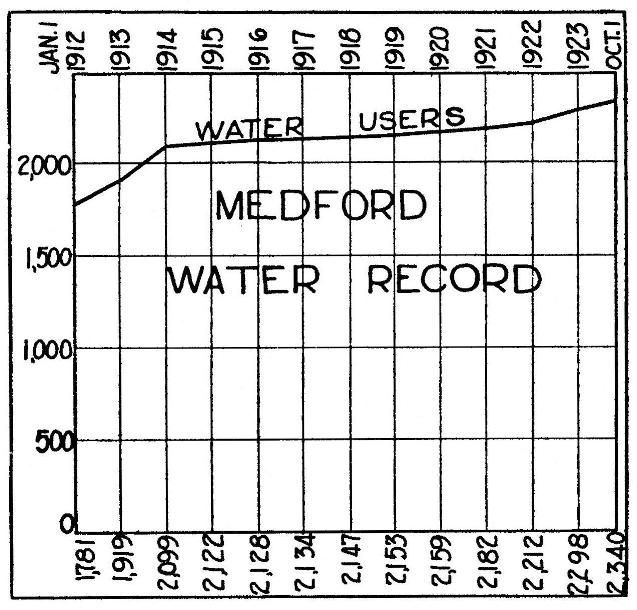 Water Users. This
chart supplements the one above showing water receipts, with the
increase in water rates eliminated. The curve is not so sensational,
but
it is certainly a curve in the right direction. A healthy, steady
growth, year by year, is shown conclusively in these two charts. More
charts will be printed Monday and continue throughout the week.
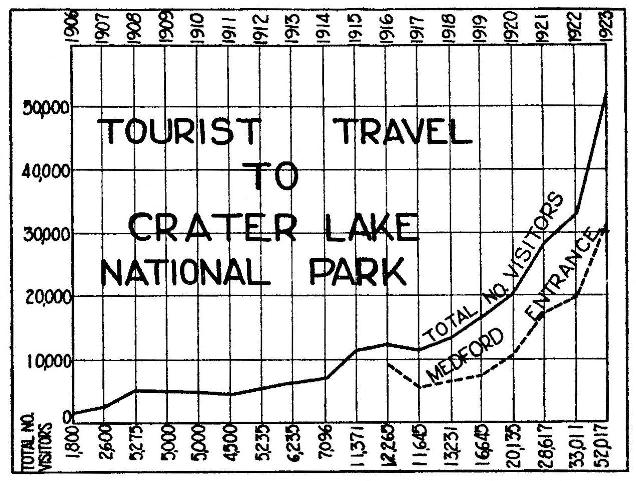 Tourist Travel.
Here is a chart that has only started. At the present rate the curve
will be higher than the Woolworth Tower in a few years. And probably no
crop is going to bring more money--outside money--into Medford and
Southern Oregon than this tourist crop, not only the tourist travel to
Crater Lake but to other points in Southern Oregon and along the
Pacific Highway. In the boom-busting days, the good old days, the
Crater Lake tourist crop totaled 4500; this year it reached a total of
52,017, an increase of about 1200 percent. And tourist travel to this
great scenic wonder has only started.
Aside from the advertising value of this tourist travel it is estimated that the tourist crop of 1923 alone was worth approximately half a million dollars to Medford and the Rogue River Valley. 1923 Automobile Camp Ground
Report.
Here is the record of the present year in Medford's auto camps:
No of.
Cars
Tourists
Municipal
camp . . . . . . . . . . . . . . . . . . . . . . 3,877
12,838
Privately owned camp . . . . . . . . . . . . . . . . . 7,111 24,896 Total . . . . . . . . . . . . . . . . . . . . . . . . . . . . 10,988 37,734 Families Staying at
Camp More
Than 30 Days
Municipal
camp . . . . . . . . . . . . . . . . . . . . . . . . . . . . . . . .
. 12
Privately owned camp . . . . . . . . . . . . . . . . . . . . . . . . . . . . 16 Total . . . . . . . . . . . . . . . . . . . . . . . . . . . . . . . . . . . . . . . . 28 Families Taking Up
Permanent Residence in Jackson Co.
Municipal camp . . . . . . . . . . . . . . . . . . . . . . . . . . . . . . . . . 30 Privately owned camp . . . . . . . . . . . . . . . . . . . . . . . . . . . . 17 Total . . . . . . . . . . . . . . . . . . . . . . . . . . . . . . . . . . . . . . . . 47
Thirty-seven thousand, seven hundred and thirty-four tourists in
Medford means hundreds of thousands of dollars spent in Medford. The
tourist crop in the "good old days" was an unknown factor, for strictly
speaking there was none. Today it is one of our best-paying crops and
is steadily increasing.
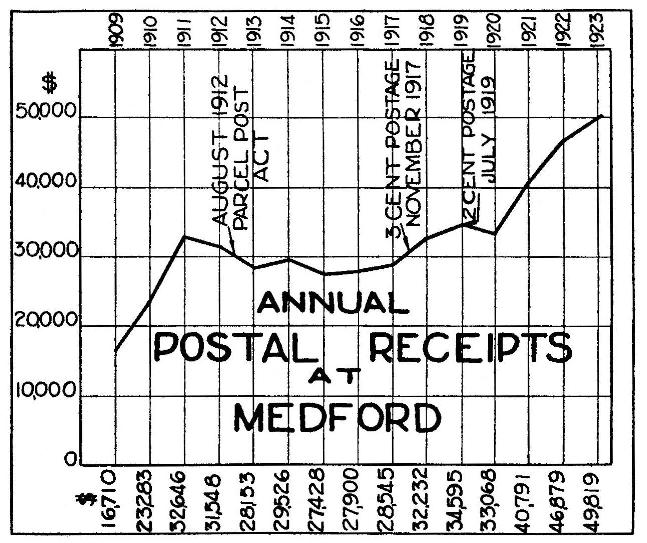 Postal Receipts.
There is no better barometer of a community's growth than postal
receipts. The chart above shows that the postal receipts in Medford
have increased by nearly 300 percent in the last fourteen years.
The peak of the 1910-11 boom is clearly shown above when from a total of $16,710 in 1909 the total reached $32,646 in 1911. Then for eight years the postal receipts fell below this total until 1918, when they jumped to $34,595 and except for 1920 have been jumping ever since. Today postal receipts are nearly 100 percent greater than they were when Medford was known as the record-breaking boom town of the Pacific coast. 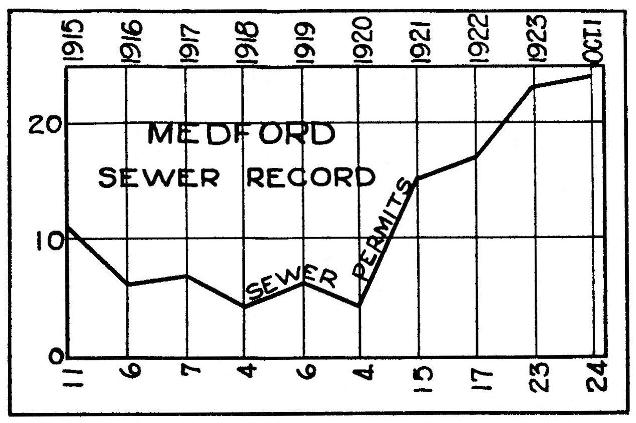
The sewer records tell the same cheering story. Quite a slump from 1915
to 1920, then a rise and steadily upward.
The Medford
1923 Cut of Timber.
1923
cut of pine (25,000 ft. to the carload) . . . . 600 carloads
Cut of fir (30,000 ft. to the carload) . . . . . . . . . . 400 carloads Total 1923 cut . . . . . . . . . . . . . . . . . . . . . . . . . 1000 carloads Equal to 25 trains of 40 cars each. ----
1923
cut of pine (25,000 ft. to the carload) . . . . 600 carloads
Manufactured in boxes before shipment . . . . . . . 400 carloads Shipped as lumber . . . . . . . . . . . . . . . . . . . . . . . . . 200 carloads Estimated
1924 Cut at Mills Now
Operating in Medford.
Pine . .
. . . . . .
. . . . . . . . . . . . . . . . . . . . . . . . . . . . . 800
carloads
Fir
. . . . . . . . . . . . . . . . . . . . . . . . . . . . . . . . . . . .
. . 700
carloads
Total 1924 cut (estimated). . . . . . . . . . . . . . . . 1500 carloads Equal to 37 trains of 40 cars each and 1 train of 20 cars.
Logs are being
transported to Medford by
the Medford-Butte Falls Logging Railroad, Southern Pacific company,
Jacksonville railroad and by logging trucks. Approximately 1500 loads
of 3000 feet each was the 1923 record of logs being transported by
trucks.
430 Men on Payroll.
During the summer 130 men were employed at the mill and factory of the
Tomlin Box Company, two shifts being employed during this period. At
the present time 70 men are at work. The Olds Lumber Company employed
an average of 300 men at their mill, in the woods and at work on their
railroad. More than the average number are employed at the present time.
----
This is practically a clear gain since 1910--for the lumber business
has been a sensational development of the last few years, and the
timber resources of Jackson County have not, as yet, been scratched.
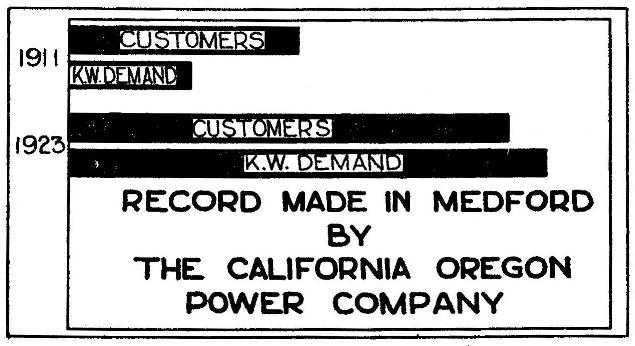
The chart above merely drives another nail in the coffin of the "good
old days" myth. Compare the customers and K.W. demand of the California
Oregon Power Company in the boom days and the same record today. The
customers in 1911 were 1315 and in 1923 they are 2504; the K.W. demand
in 1911 as 700 and in 1923 2724. Nearly 100 percent increase in
customers and nearly 400 percent increase in K.W. demand. And this
growth moreover is typical of Medford today, in practically every line
of business, as further documents will demonstrate.
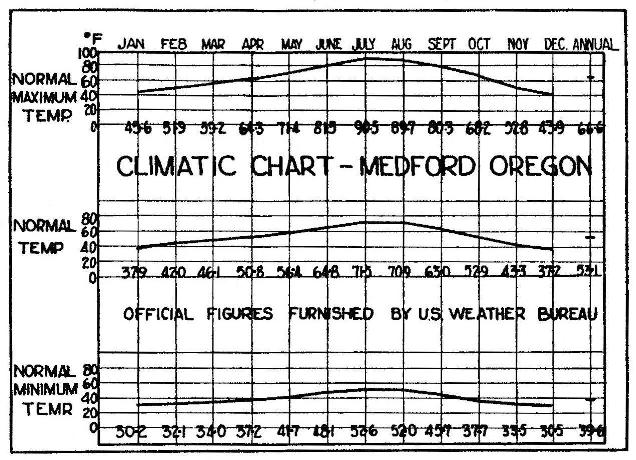 Climate.
A few words about climate. If a perfect climate is a mean between two
extremes--and experts declare it is--then Medford has the perfect
climate. Look at the two charts above showing the range of temperature
and the precipitation. From the standpoint of an artist in weather,
could anything be more nearly perfect?
No extreme cold snaps, no extreme hot spells, no cloudbursts, no floods, no parched Sahara weather. Unfortunately the humidity is not charted, but it should be noted that thanks to a low humidity, 90 degrees in Medford is less oppressive than 75 in the East and Middle West. The normal maximum ranges from 45.6 to 90.5, and the normal minimum from 30.2 (just below freezing) to 52.6. The normal average temperature ranges from 37.9 to 71.5. A climate like that for health and general well-being could scarcely be surpassed. 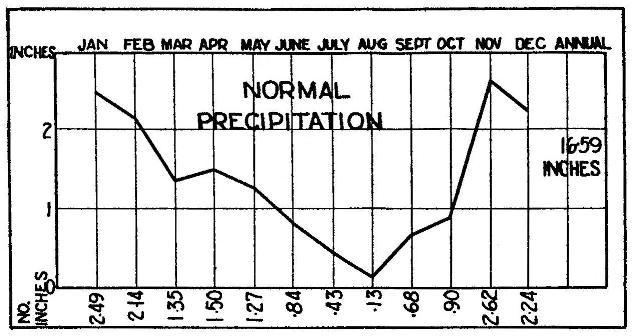
Now as to rainfall. There is an unfortunate impression outside of
Oregon
that Oregon is a cross between a frog pond and a London fog. It may be
admitted that along the Oregon coast it rains a great deal, in some
places over 100 inches annually. But look at Medford's rainfall--a
normal average of 16.59 inches!
San Francisco, with its glorious California climate, has an average rainfall of 22 inches annually, nearly 4 inches greater. Moreover, during the spring, summer and early fall months, when the average person is most anxious to enjoy the out-of-doors, there is practically continual sunshine in the Rogue River Valley. Finally, these charts are not booster literature. They are based upon official reports of the U.S. Weather Bureau--the final word in climate data. In this connection it may be noted in addition to the best trout fishing in the world and wild game hunting that cannot be excelled, Medford will have in 1924 one of the best golf courses on the coast, laid out by a Medford rancher, H. Chandler Egan, former national amateur golf champion and present golf champion of the Pacific Coast. Perfect weather, unequaled outdoor sports! As a place to not only live, but enjoy life, Medford and the Rogue River Valley can't be surpassed. 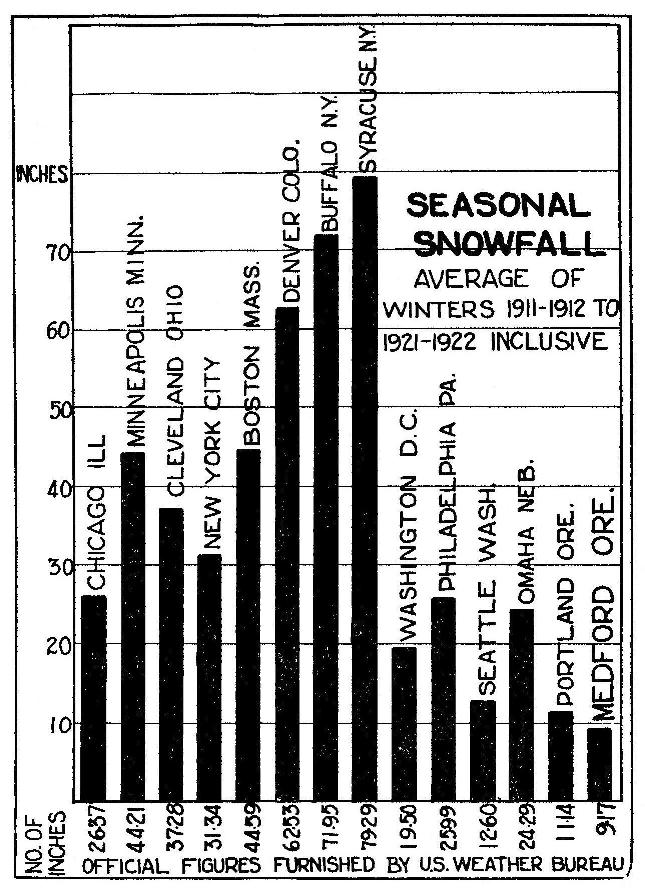 Seasonal Snowfall.
The following chart shows that Medford has a seasonal average of 9.17
inches of snow, which will be a great surprise to many residents of the
city, for snow is seldom seen, except on the peaks of the Siskiyous or
the peaks of the Cascade or Coast ranges far in the distance. The fact
is, however, some snow falls on during the winter months but usually
disappears at once, because of the relative high average temperature.
Those people who wish to escape blizzards and the rigors of the East
and the Middle West could find no better place in the Northwest,
however, than Medford. For the chart above shows Medford has less
snowfall than either Portland or Seattle, and less than half the
snowfall of Washington, D.C. Yet now and then there is a touch of
winter--just enough to tingle the blood and prevent the monotony of a
one-season and debilitating climate.
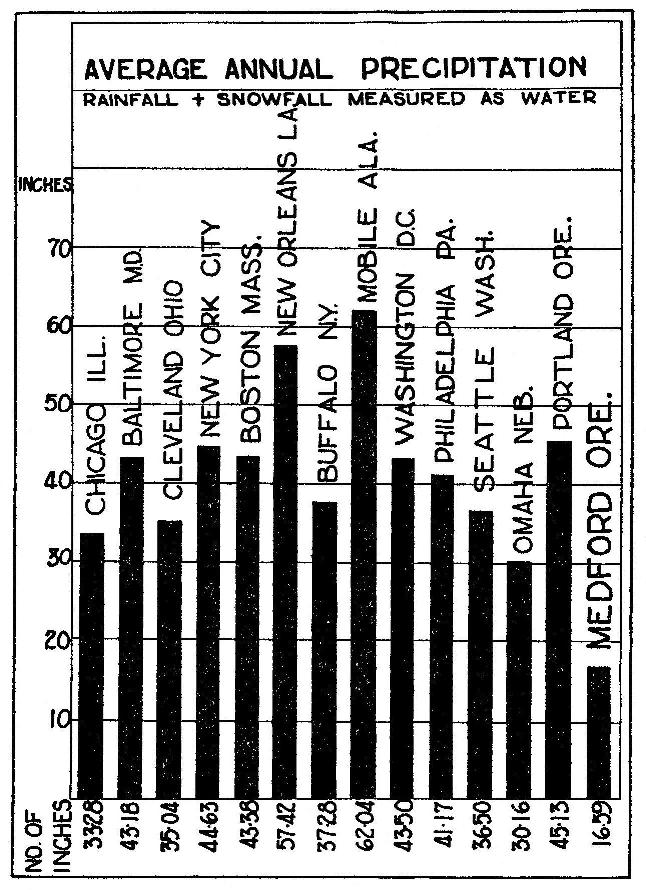
The table above finally disposes of the myth that Southern Oregon is
part of a Webfoot state. Medford has less than half the rainfall of
Portland and Seattle and is far below Washington, D.C. and New York
City. What the table above doesn't show, however, is that the average
rainfall in San Francisco, California is nearly four inches more than
in Medford, while the average rainfall in Santa Rosa, California, where
Luther Burbank extols the wonders of California sunshine, the average
rainfall is twice as great as in Medford. Statistics of the U.S.
Weather Bureau demonstrate that the climate of Southern Oregon is
indeed hard to beat.
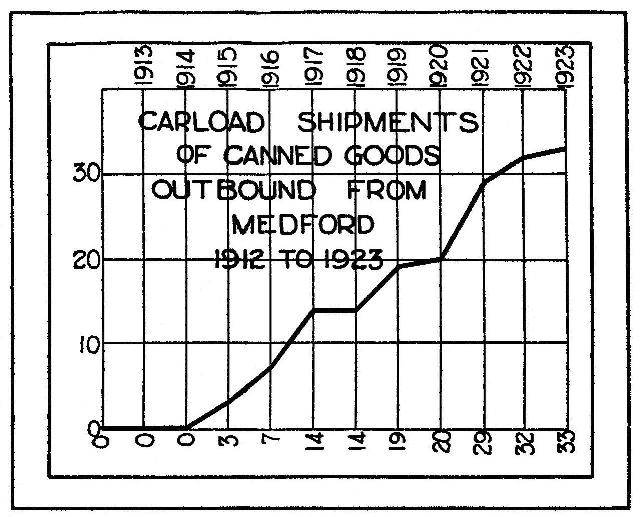 Medford Shipments of Canned Fruits.
Here is another Medford industry which did not exist in the "good old
days," but which is now very much alive and growing steadily.
Conditions
bearing no relation to the cannery possibilities in the Rogue River
Valley have restricted the local output somewhat, but from 3 cars in
1915 to 33 cars in 1923 is certainly a long jump in the right direction.
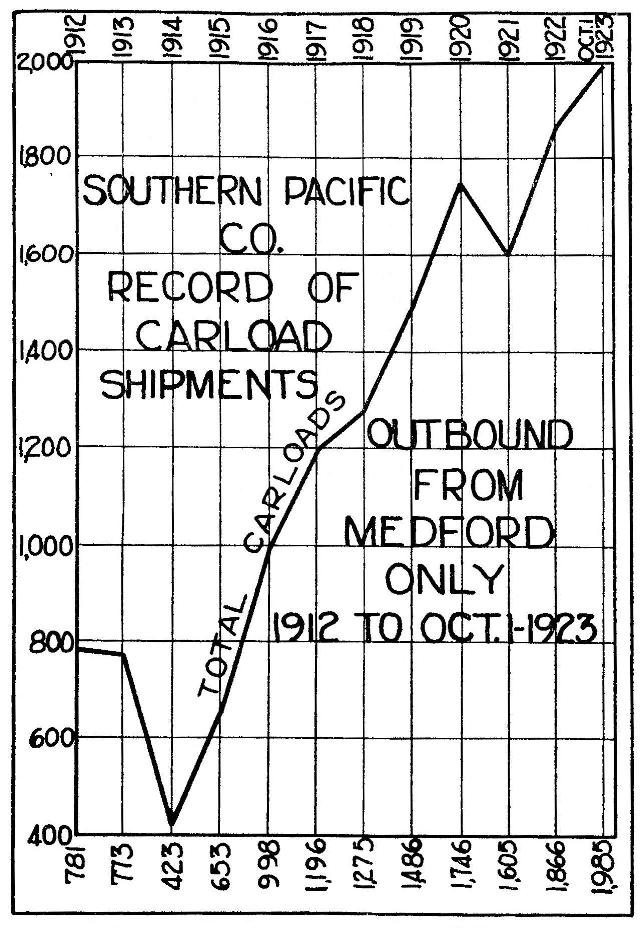 Medford Outbound Shipments.
As the [above] chart shows, Medford is shipping out over a thousand and
more carloads of produce annually now than when the city was breaking
the speed record as the fastest-growing town on the Pacific coast.
Seven hundred and eighty-one carloads were sent out from Medford alone in 1912, then the shipments fell down to only 423 in 1914, but since that time they have been steadily rising, until this year when in only ten months the total reached 1985, and for the year the total will exceed 2000 by a large margin. It should be noted that the above chart includes only the Medford shipments. From Medford and Jackson County in 1923, approximately 2000 cars of pears alone were shipped out. 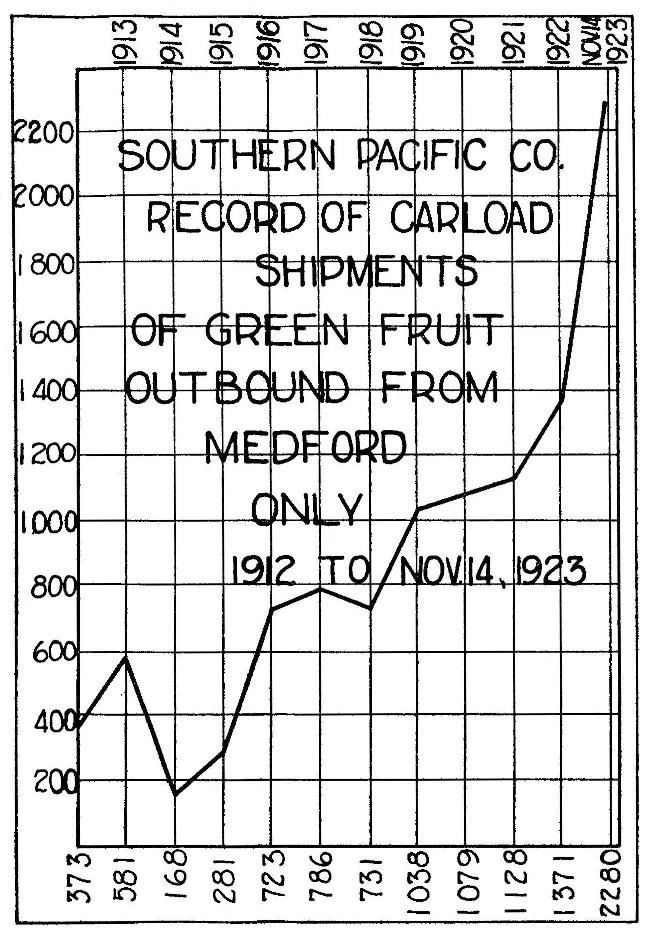
This chart might also be labeled the effect of irrigation in Medford
and
the Rogue River Valley. See how the curve jumps from from 1920 to 1923
when water became available to local orchardists--production doubled in
4 years.
The above chart only includes Medford shipments to November 15th, 1923. To date, that is December 7th, 1923, the total shipments of pears and apples from the Medford station totals 1808 pears and 558 apples or a grand total of these two fruits alone of 2366 cars. Compare this with a total of 373 cars in 1912, and only 168 cars in 1914, and one gets some idea of the growth and monetary value of the fruit crop, with the increase in bearing acreage and the installation of a comprehensive irrigation system.. County Production Statistics.
The
growth of Medford would not be of a substantial character without a
corresponding growth and development of the agricultural and
horticultural industries of Jackson County.
A marked advance in production has been made in the county, and comparisons are here submitted. Gain over
1911 1923 1911 Acres
of irrigated land . . . . . . . . . . . . . . . . . 7,500
35,000 27,500
Carloads pears (in round numbers) . . . . . . . . 500 2,000 1,500 Acres of alfalfa . . . . . . . . . . . . . . . . . . . . . . . 7,000 20,000 13,000 Acres of corn. . . . . . . . . . . . . . . . . . . . . . . . . 4,000 8,000 4,000 Number of hogs. . . . . . . . . . . . . . . . . . . . . . 10,800 12,000 1,300 Number of dairy cows (inc. young stock) . 3,500 6,500 3,000 No. of farms having more than 200 hens . . . 10 100 90
In 1911
sufficient turkeys were raised to supply home trade, and a very few
small express shipments were made. In 1923 several carloads of turkeys
were shipped, and it is estimated that one thousand percent more
turkeys are being produced this year than in 1911.
The statement above shows again and in emphatic fashion the great increase in production in Jackson County since the "good old days of 1911-12"--500 cars of pears for example in 1911, 2000 cars in 1923--production quadrupled in 12 years. 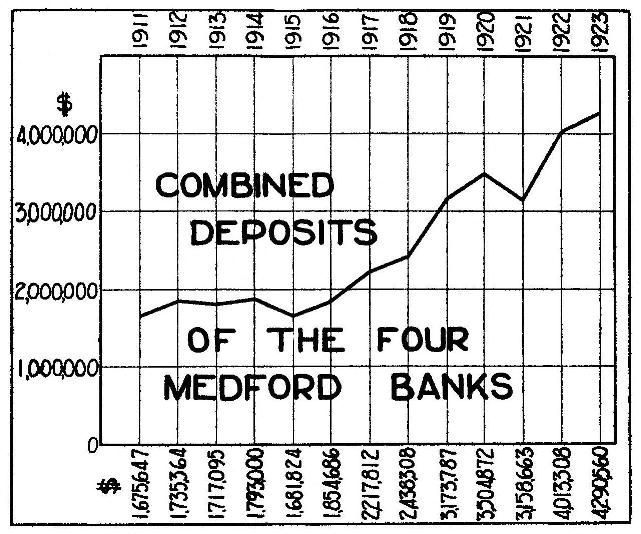 Bank Deposits.
Yes,
money talks! In the chart above it not only talks, it yells. In the
"good old days" a million-and-a-half-dollar bank total was proclaimed
an epoch-making achievement. Now Medford has a total of bank deposits
well over $4,000,000. (And the returns from the bumper pear
crop of 1923 are not yet all in!) If there are any members of
the
anvil chorus still at large, this chart alone should be enough to send
them to cover. Over two and one-half times as much money on deposit in
Medford today as there was in the days of Medford's boom!
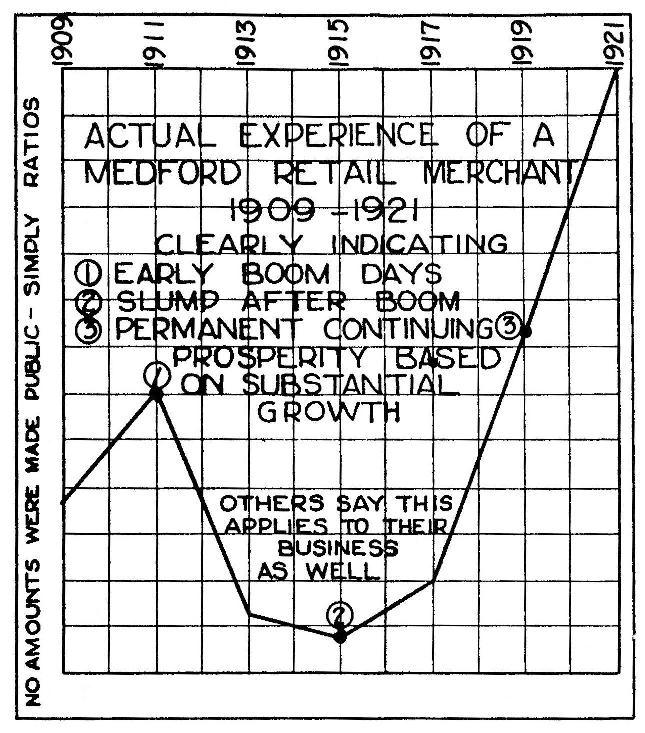 Experience [of a] Medford Business Man.
For
obvious reasons the name of the business man whose report is
given above can't be announced, but this is a bona fide report
voluntarily made by a representative business man of this city. It is
undoubtedly true that there is scarcely a business man in Medford who
isn't enjoying a better and more profitable business today than ever
before in Medford's history.
Conclusion.
These
charts today complete the economic survey of Medford. As was stated at
the outset a complete survey of the city and surrounding country, or an
exhaustive survey in any one department, was not attempted.
What was attempted, and what we believe has been accomplished, was to show by the presentation of official facts supported by undisputed evidence that Medford's business conditions today are better than they were in those good old boom days--better than they ever have been before. There have been varying degrees of growth and betterment, shown in various departments, ranging all the way from 50 to 5000 percent, but in every instance from sewer permits to telephones, from produce shipments to tourist travel, from building permits to bank deposits--THERE HAS BEEN GROWTH--consistent, substantial, wholesome growth. Moreover, in not a single instance has there been a decline of recent date, and in every instance the record of 1923 HAS SURPASSED THE RECORD OF ANY PREVIOUS YEAR IN THE CITY'S HISTORY. So there is Medford as she is today--in every way bigger and better than ever before, a statement based not on hot air or guesswork but on the solid foundation of the official records. And what is the moral? The moral, as we see it, is this: Medford has more of everything today than she ever had before except spirit. By "spirit" we mean civic spirit, the old-time Medford spirit, the spirit of enthusiasm, of self-confidence of united aggressive effort, the spirit of faith in our city, faith in ourselves, the faith to do things--big things in a big way. That spirit is the only thing we need now to achieve the benefits which the material conditions justify. It shouldn't be difficult. For the elements of which that spirit should be a product ARE HERE!! Before being gathered into a booklet, the above editorials were serialized in the Medford Mail Tribune November 30 through December 8, 1923. Last revised January 2, 2022 |
|
| |
|
|

